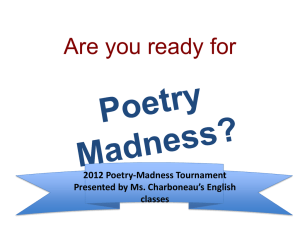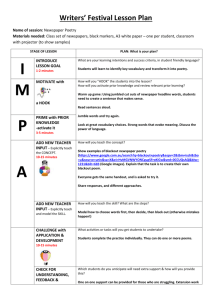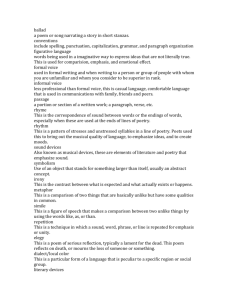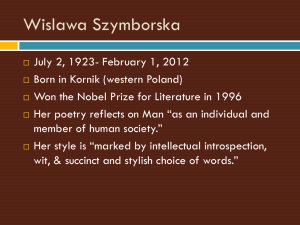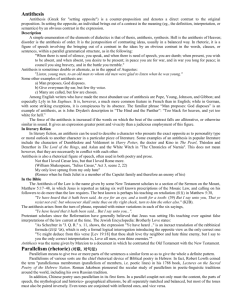Poetry Literary Terms
advertisement
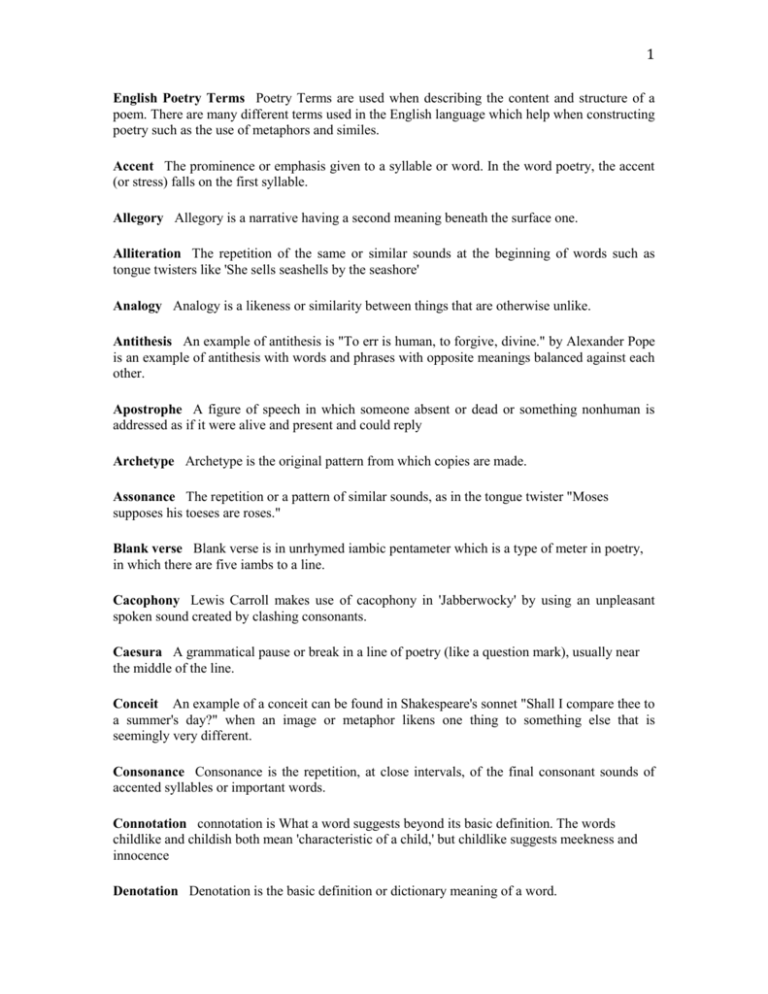
1 English Poetry Terms Poetry Terms are used when describing the content and structure of a poem. There are many different terms used in the English language which help when constructing poetry such as the use of metaphors and similes. Accent The prominence or emphasis given to a syllable or word. In the word poetry, the accent (or stress) falls on the first syllable. Allegory Allegory is a narrative having a second meaning beneath the surface one. Alliteration The repetition of the same or similar sounds at the beginning of words such as tongue twisters like 'She sells seashells by the seashore' Analogy Analogy is a likeness or similarity between things that are otherwise unlike. Antithesis An example of antithesis is "To err is human, to forgive, divine." by Alexander Pope is an example of antithesis with words and phrases with opposite meanings balanced against each other. Apostrophe A figure of speech in which someone absent or dead or something nonhuman is addressed as if it were alive and present and could reply Archetype Archetype is the original pattern from which copies are made. Assonance The repetition or a pattern of similar sounds, as in the tongue twister "Moses supposes his toeses are roses." Blank verse Blank verse is in unrhymed iambic pentameter which is a type of meter in poetry, in which there are five iambs to a line. Cacophony Lewis Carroll makes use of cacophony in 'Jabberwocky' by using an unpleasant spoken sound created by clashing consonants. Caesura A grammatical pause or break in a line of poetry (like a question mark), usually near the middle of the line. Conceit An example of a conceit can be found in Shakespeare's sonnet "Shall I compare thee to a summer's day?" when an image or metaphor likens one thing to something else that is seemingly very different. Consonance Consonance is the repetition, at close intervals, of the final consonant sounds of accented syllables or important words. Connotation connotation is What a word suggests beyond its basic definition. The words childlike and childish both mean 'characteristic of a child,' but childlike suggests meekness and innocence Denotation Denotation is the basic definition or dictionary meaning of a word. 2 Dialect Dialect refers to pronunciation of a particular region of a Country or region. Enjambment Enjambment comes from the French word for "to straddle." Enjambment is the continuation of a sentence form one line or couplet into the next and derives from the French verb 'to straddle'. An example by Joyce Kilmer is 'I think that I shall never see/A poem as lovely as a tree'. Epithet An epithetis a a descriptive expression, a word or phrase expressing some quality or attribute. Euphony Euphony refers to pleasant spoken sound that is created by smooth consonants such as "ripple'. Euphemism Euphemism is the use of a soft indirect expression instead of one that is harsh or unpleasantly direct. For example 'pass away' as opposed to 'die' Feminine rhyme A rhyme that occurs in a final unstressed syllable: pleasure/leisure, longing/yearning. Figure of speech A verbal expression in which words or sounds are arranged in a particular way to achieve a particular effect such as alliteration, antithesis, assonance, hyperbole, metaphor, onomatopoeia and simile. Hyperbole Hyperbole (overstatement) is a type of figurative language that depends on intentional overstatement. Idiom Idiom refers to words, phrases, or patterns of expression. Idioms became standard elements in any language, differing from language to language and shifting with time. A current idiom is 'getting in a car' but 'on a plane'. Imagery Imagery draws the reader into poetic experiences by touching on the images and senses which the reader already knows. Irony Irony is a situation, or a use of language, involving some kind of discrepancy. An example of this is ''Water, water everywhere but ne'er a drop to drink'. Jargon Jargon refers to words and phrases developed by a particular group to fit their own needs which other people understand. Litotes A litote is a figure of speech in which affirmative is expressed by the negation of the opposite. "He's no dummy" is a good example. Metaphor A metaphor is a pattern equating two seemingly unlike objects. An examples of a metaphor is 'drowning in debt'. Meter Meters are regularized rhythms. An arrangement of language in which the accents occur at apparently equal intervals in time. Each repeated unit of meter is called a foot. 3 Meiosis Meiosis is a figure of speech that consists of saying less than one means, or of saying what one means with less force than the occasion warrants. Metonymy A figure of speech in which one word is substituted for another with which it is closely associated. Some significant aspect or detail of an experience is used to represent the whole experience. Onomatopoeia A figure of speech in which words are used to imitate sounds. Examples of onomatopoeic words can be found in numerous Nursery Rhymes e.g. clippety-clop and cock-adoodle-do. Paradox A paradox is a statement or situation containing apparently contradictory or incompatible elements. Pentameter A line of poetry that has five metrical feet. Persona Persona refers to the narrator or speaker of the poem, not to be confused with the author. Personification Personification means giving human traits to nonhuman or abstract things. Refrain A phrase, line, or group of lines that is repeated throughout a poem, usually after every stanza. Rhyme The occurrence of the same or similar sounds at the end of two or more words. Rhythm Rhythm is significant in poetry because poetry is so emotionally charged and intense. Rhythm can be measured in terms of heavily stressed to less stressed syllables. Rhythm is measured in feet, units usually consisting of one heavily accented syllable and one or more lightly accented syllable. Scansion The analysis of a poem's meter. This is usually done by marking the stressed and unstressed syllables in each line and then, based on the pattern of the stresses, dividing the line into feet. Simile A figure of speech in which two things are compared using the word "like" or "as" to draw attention to similarities about two things that are seemingly dissimilar. Slang Slang refers to highly informal and sub-standard vocabulary which may exist for some time and then vanish. Some slang remains in usage long enough to become permanent, but slang never becomes a part of formal diction. Stress Stress refers to the accent or emphasis, either strong or weak, given to each syllable in a piece of writing, as determined by conventional pronunciation. Synecdoche Synecdoche is a figure of speech in which a part is used for the whole. 4 Syntax Syntax refers to word order and sentence structure. Normal word order in English sentences is firmly fixed in subject-verb-object sequence or subject-verb-complement. In poetry, word order may be shifted around to meet emphasis, to heighten the connection between two words, or to pick up on specific implications or traditions. Trope Trope is the use of a word or phrase in a sense different from its ordinary meaning. Understatement Understatement refers to the intentional downplaying of a situation's significance, often for ironic or humorous effect.


